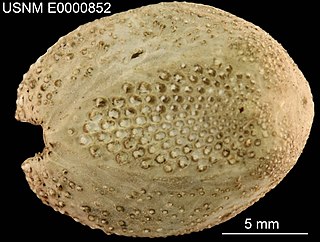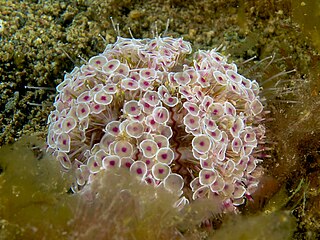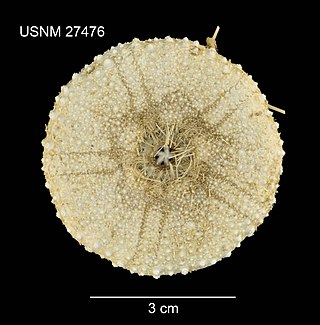Related Research Articles

Acanthocidaris hastigera is a species of sea urchin of the family Cidaridae. Their armour is covered with spines. It is in the genus Acanthocidaris and lives in the sea. Acanthocidaris hastingeria was first scientifically described in 1907 by Alexander Emanuel Agassiz & Hubert Lyman Clark.

Aceste ovata is a species of sea urchin of the family Schizasteridae. Their armour is covered with spines. It came from the genus Aceste and lives in the sea. Aceste ovata was first scientifically described in 1907 by Alexander Emanuel Agassiz & Hubert Lyman Clark.
Aporocidaris fragilis is a species of sea urchin of the family Ctenocidaridae. It is well-armoured with spines. It is placed in the genus Aporocidaris and lives in the sea. Aporocidaris fragilis was first scientifically described in 1907 by Alexander Emanuel Agassiz & Hubert Lyman Clark.

Araeosoma coriacea is a species of sea urchin of the family Echinothuriidae. Its armour is covered with spines. It is placed in the genus Araeosoma and lives in the sea. A. coriacea was first scientifically described in 1879 by Alexander Emanuel Agassiz, an American scientist.

Araeosoma coriaceum is a species of sea urchin of the family Echinothuriidae. Its armour is covered with spines. It is placed in the genus Araeosoma and lives in the sea. A. coriaceum was first scientifically described in 1879 by Alexander Emanuel Agassiz, an American scientist.
Araeosoma fenestratum is a species of sea urchin of the family Echinothuriidae. Its armour is covered with spines. It is placed in the genus Araeosoma and lives in the sea. A. fenestratum was first scientifically described in 1872 by Thomson.

Araeosoma leptaleum is a species of sea urchin of the family Echinothuriidae. Its armour is covered with spines. It is placed in the genus Araeosoma and lives in the sea. A. leptaleum was first scientifically described in 1909 by Alexander Emanuel Agassiz & Hubert Lyman Clark.

Araeosoma parviungulatum is a species of sea urchin of the family Echinothuriidae. Their armour is covered with spines. It is placed in the genus Araeosoma and lives in the sea. Araeosoma parviungulatum was first scientifically described in 1934 by Ole Theodor Jensen Mortensen.
Araeosoma paucispinum is a species of sea urchin of the family Echinothuriidae. Its armour is covered with spines. It is placed in the genus Araeosoma and lives in the sea. A. paucispinum was first scientifically described in 1924 by Hubert Lyman Clark, an American zoologist.
Araeosoma tessellatum is a species of sea urchin of the family Echinothuriidae. Its armour is covered with spines. It is placed in the genus Araeosoma and lives in the sea. A. tessellatum was first scientifically described in 1879 by Alexander Emanuel Agassiz.

Araeosoma thetidis is a species of sea urchin of the family Echinothuriidae that lives in deep sea off Australia and New Zealand. A. thetidis was first scientifically described in 1909 by Hubert Lyman Clark.

Toxopneustes is a genus of sea urchins from the tropical Indo-Pacific. It contains four species. They are known to possess medically significant venom to humans on their pedicellariae. They are sometimes collectively known as flower urchins, after the most widespread and most commonly encountered species in the genus, the flower urchin.
Argopatagus planus is a species of sea urchin of the family Macropneustidae. Their armour is covered with spines. It is placed in the genus Argopatagus and lives in the sea. Argopatagus planus was first scientifically described in 1907 by Alexander Emanuel Agassiz and Hubert Lyman Clark, American scientists.
Caenopedina pulchella is a species of sea urchins of the family Pedinidae. Their armour is covered with spines. Caenopedina pulchella was first scientifically described in 1907 by Alexander Emanuel Agassiz and Hubert Lyman Clark.
Centrostephanus asteriscus is a species of sea urchin of the family Diadematidae. Their armour is covered with spines. Centrostephanus asteriscus was first scientifically described in 1907 by Alexander Emanuel Agassiz & Hubert Lyman Clark.

Chaetodiadema pallidum is a species of sea urchins of the Family Diadematidae. Their armour is covered with spines. Chaetodiadema pallidum was first scientifically described in 1907 by Alexander Emanuel Agassiz and Hubert Lyman Clark.

Chaetodiadema is a genus of sea urchins of the Family Diadematidae. Their armour is covered with spines.

Toxopneustes roseus is a species of sea urchin from the East Pacific. It is sometimes known as the rose flower urchin or the pink flower urchin. Like the related flower urchin, they are venomous.

Toxopneustes maculatus is a rare species of sea urchin found in the Indo-West Pacific.

Araeosoma is a genus of deep-sea sea urchins in the family Echinothuriidae.
References
- ↑ Kroh, A. (2010). Araeosoma eurypatum (Alexander Emanuel Agassiz & Hubert Lyman Clark, 1909). In: Kroh, A. & Mooi, R. (2010) World Echinoidea Database. at the World Register of Marine Species.
